The secret to a successful fishing trip often lies beyond the bait you use or the time of day. It involves interpreting the water itself. By reading water conditions for better fishing, you can anticipate fish behavior, locate their hiding spots, and level up your angling game. Below are five essential tips that every angler should be aware of.
Weather Patterns and Their Impact
Keep your eye on weather forecasts before you head out. Weather plays a pivotal role in fish activity and movement. Pay close attention to how rain and thunderstorms impact bay fishing, as these conditions can significantly alter water temperatures, oxygen levels, and even fish feeding habits. For instance, post-storm waters may bring fish closer to shallow areas due to increased oxygen levels or stirred-up baitfish.
Observe Water Clarity
Water clarity can give you clues about fish behavior and the type of bait to use. Clear water means fish are more likely to see your lure, so choose a more natural-looking bait to mimic small prey. On the other hand, murky water tends to make fish rely more on their sense of vibration and scent, making spinnerbaits and scented soft plastics a more effective choice.
Look for Structure and Cover
Fish love to congregate around underwater structures such as rocks, fallen trees, or vegetation. These areas offer shelter from predators and serve as hunting grounds for baitfish. Identifying these “hotspots” can save you time and ensure more productive fishing. Utilize polarized sunglasses, which reduce glare on the water surface, to help spot structures more clearly.
Pay Attention to Current and Tides
Currents and tides are nature’s conveyor belts, bringing food to lazy predators waiting in the water. If you’re fishing in tidal waters, focus on hours when tides are changing, as fish are more active during these periods. Similarly, the direction and strength of currents can inform you where fish might be waiting to ambush their prey.
Watch for Surface Activity
Keep an eye out for telltale signs of feeding fish. Birds circling above the water often signal the presence of schools of baitfish, which in turn attract larger fish. Ripples, splashes, or “boiling” water may indicate active fish near the surface. This is your cue to cast a lure or fly bait into the action-packed area!
Reading water conditions for better fishing is both an art and a science. Mastering this skill can transform your next fishing trip. Gear up, grab your tackle box, and put these tips into practice on your next adventure!





